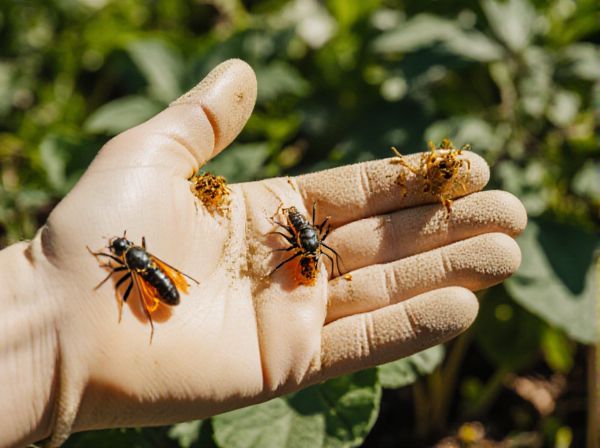
Beneficial insect hosts vs sacrificial plants Illustration
Beneficial insect hosts attract natural predators and pollinators, enhancing pest control and boosting crop yields by creating a balanced ecosystem. Sacrificial plants divert pests away from valuable crops, minimizing damage but do not contribute directly to the overall health of beneficial insect populations. Using a combination of both strategies maximizes pest management efficiency and supports sustainable gardening practices.
Table of Comparison
| Category | Beneficial Insect Hosts | Sacrificial Plants |
|---|---|---|
| Purpose | Attract and sustain beneficial insects (pollinators, predators) | Divert pests away from main crops |
| Common Examples | Fennel, dill, yarrow, alyssum | Radishes, mustard, nasturtiums |
| Function | Enhance pest control and pollination naturally | Reduce pest damage on valuable plants |
| Impact on Main Crop | Positive (boost growth and yield) | Protective (minimizes pest pressure) |
| Maintenance | Requires planting for bloom cycles | Often replaced after pest control |
Understanding Beneficial Insect Hosts
Beneficial insect hosts provide essential habitats and food sources that support the survival and reproduction of predator and pollinator species, enhancing natural pest control and crop pollination. These hosts attract and sustain beneficial insects such as ladybugs, lacewings, and parasitic wasps, which reduce pest populations by preying on or parasitizing harmful insects. Recognizing the role of beneficial insect hosts in garden ecosystems is crucial for designing companion planting strategies that promote biodiversity and plant health.
What Are Sacrificial Plants in Gardening?
Sacrificial plants in gardening are deliberately planted to attract and divert harmful pests away from valuable crops, protecting companion plants by acting as pest magnets. These plants often host beneficial insects such as ladybugs or predatory wasps that help control pest populations naturally, reducing the need for chemical pesticides. By serving as pest decoys and supporting insect hosts, sacrificial plants promote a balanced garden ecosystem and enhance plant health.
Comparing Beneficial Hosts and Sacrificial Plants
Beneficial insect hosts attract and sustain predatory and pollinator species by providing nectar, pollen, or habitat, thereby enhancing biological pest control and biodiversity in gardens. Sacrificial plants, planted specifically to lure pests away from valuable crops, reduce pest damage but do not directly support natural enemy populations. Comparing the two, beneficial hosts improve ecosystem balance by fostering beneficial insect populations, while sacrificial plants act as targeted pest traps, offering different but complementary pest management strategies.
Attracting Natural Predators with Host Plants
Companion planting with beneficial insect hosts effectively attracts natural predators like ladybugs, lacewings, and parasitic wasps, enhancing biological pest control in gardens. Specific host plants, such as dill, fennel, and yarrow, provide nectar, pollen, and shelter that support these predators' life cycles and increase their presence. Integrating sacrificial plants like mustard or nasturtium can also divert pests, but strategic use of true host plants maximizes predator attraction and long-term pest regulation.
How Sacrificial Plants Protect Your Crops
Sacrificial plants act as decoys by attracting pests away from valuable crops, reducing damage and preserving yield. These plants create a protective buffer, drawing harmful insects to themselves and minimizing the need for chemical pesticides. By strategically integrating sacrificial plants, farmers enhance crop resilience and promote ecological balance in agricultural ecosystems.
Selecting the Right Host Plants for Your Garden
Choosing beneficial insect hosts such as flowering herbs, milkweed, and native nectar plants supports natural pest control by attracting pollinators and predatory insects. Sacrificial plants like nasturtiums and marigolds divert pests away from valuable crops, reducing damage without chemicals. Selecting the right host plants enhances garden biodiversity and promotes a healthy ecosystem, improving overall plant resilience.
Popular Sacrificial Plants for Pest Management
Popular sacrificial plants such as marigolds, nasturtiums, and sunflowers are strategically used in pest management to attract pests away from valuable crops, effectively reducing pest pressure. These plants serve as decoys, drawing harmful insects like aphids and whiteflies, which allows beneficial insect hosts, such as ladybugs and lacewings, to thrive and enhance natural pest control. Incorporating sacrificial plants into companion planting schemes creates a balanced ecosystem, promoting plant health and reducing the need for chemical pesticides.
Balancing Biodiversity: Hosts vs Sacrificials
Beneficial insect hosts provide essential habitats and food sources that support pollinators and predators, promoting a natural pest control balance within garden ecosystems. Sacrificial plants attract pests away from valuable crops, reducing damage but potentially limiting resources for beneficial insects if overused. Balancing these elements maintains biodiversity by ensuring that beneficial insects thrive while pests are managed effectively, leading to a healthier, more resilient garden environment.
Integrated Pest Management Strategies
Beneficial insect hosts, such as flowering plants that attract predatory beetles or parasitic wasps, play a crucial role in Integrated Pest Management (IPM) by naturally controlling pest populations. Sacrificial plants, also known as trap crops, divert pests away from main crops, reducing damage and enhancing the effectiveness of beneficial insects. Strategic deployment of both beneficial insect hosts and sacrificial plants optimizes biological control, minimizes chemical pesticide use, and supports sustainable agriculture.
Tips for Success: Combining Hosts and Sacrificial Plants
Combining beneficial insect hosts with sacrificial plants enhances pest control by attracting and sustaining natural predators while diverting pests away from valuable crops. Planting diverse insectary plants such as dill, fennel, and yarrow near sacrificial crops like mustard or nasturtium creates a balanced ecosystem that supports beneficial insects like ladybugs, lacewings, and parasitic wasps. Regular monitoring and adaptive planting strategies ensure optimal synergy, maximizing pest suppression and promoting healthier garden biodiversity.
Beneficial insect hosts vs sacrificial plants Infographic

 gardendif.com
gardendif.com